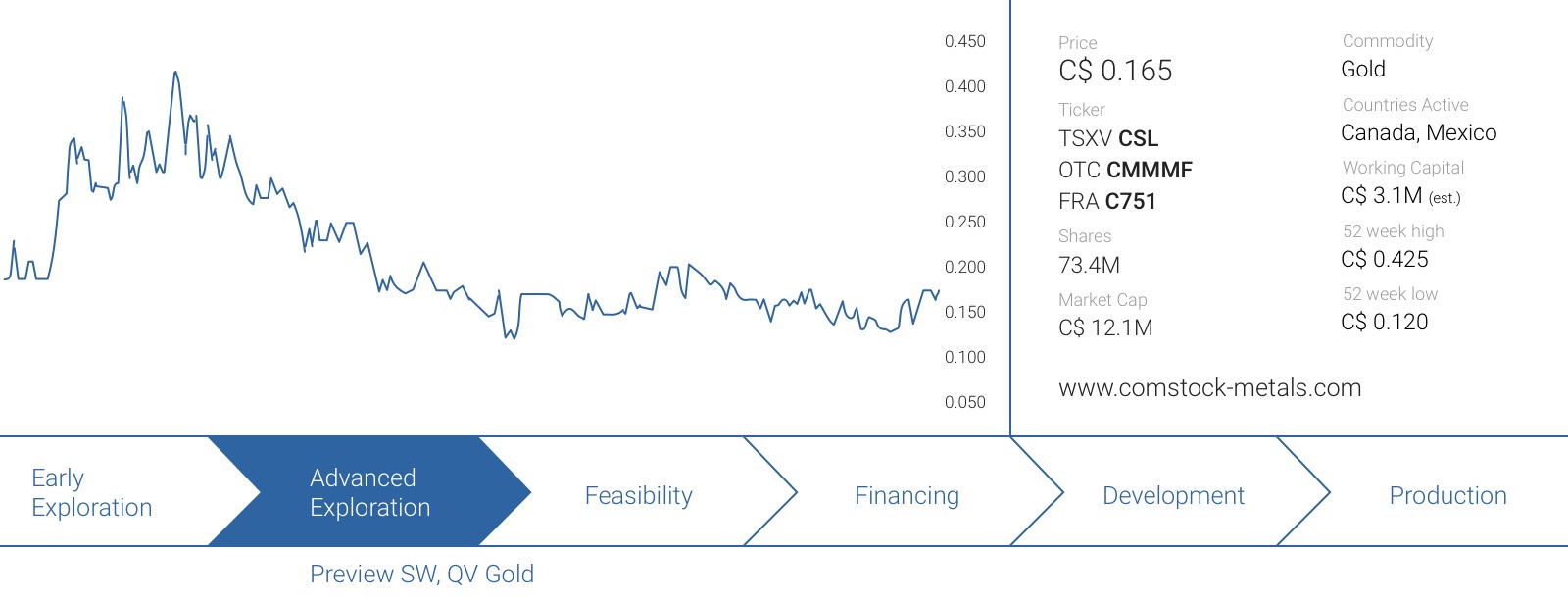Sometimes an asset could benefit from a new pair of eyes looking at it, and that’s exactly what Comstock Metals (CSL.V) is doing after it acquired the Preview SW gold project (hereafter called ‘Preview’ as well) in Saskatchewan from Select Sands (SNS.V) which is now focusing on frac sand. Preview isn’t Comstock’s only project as it also owns the QV Gold property in the Yukon Territory.
Even though there seems to be a new rush to search for gold in the Yukon, Comstock has owned this project for quite a while now, and it even has a few hundred thousand ounces in a NI43-compliant resource estimate whilst last year’s drill results confirm the prospectivity of the area Comstock is drilling.
Introducing you to the company’s projects
A. Preview SW, Saskatchewan
We consider the Preview SW project to be Comstock’s flagship asset as it could be cheap and easy to add ounces to the current resource estimate.
The project has a total surface area of just over 850 hectares and is located approximately 250 kilometers north of Prince Albert, and 40 kilometers north of La Ronge. Saskatchewan indeed isn’t the first Canadian province that would come to mind when you’re thinking about gold projects, but it actually is one of the best areas to explore and develop, according to the Fraser Institute (see later).
It’s also easier when you don’t have to start from scratch, and Comstock Metals was able to acquire this asset with an existing resource estimate and a pretty good understanding of the geological structures dominating the land package.
Although the previous operators and Comstock have confirmed no less than seven known gold prospects on the property, only ONE zone has seen a sufficient amount of drilling to allow the independent consultants to complete a resource estimate. The entire gold resource containing almost 430,000 ounces at an average grade of approximately 1.61 g/t (the weighted average of the indicated and inferred ounces) is limited to the Preview SW zone which emphasizes the blue sky exploration potential at the under-explored gold zones along strike from the deposit.
The deposit consists of several sub-parallel gold-bearing structures trending towards the north-east. All these structures are very close to each other, and the width of the mineralized ‘corridor’ is approximately 150 meters. This means the zone is quite compact and pretty consistent, allowing Comstock to ‘chase’ mineralized structures.
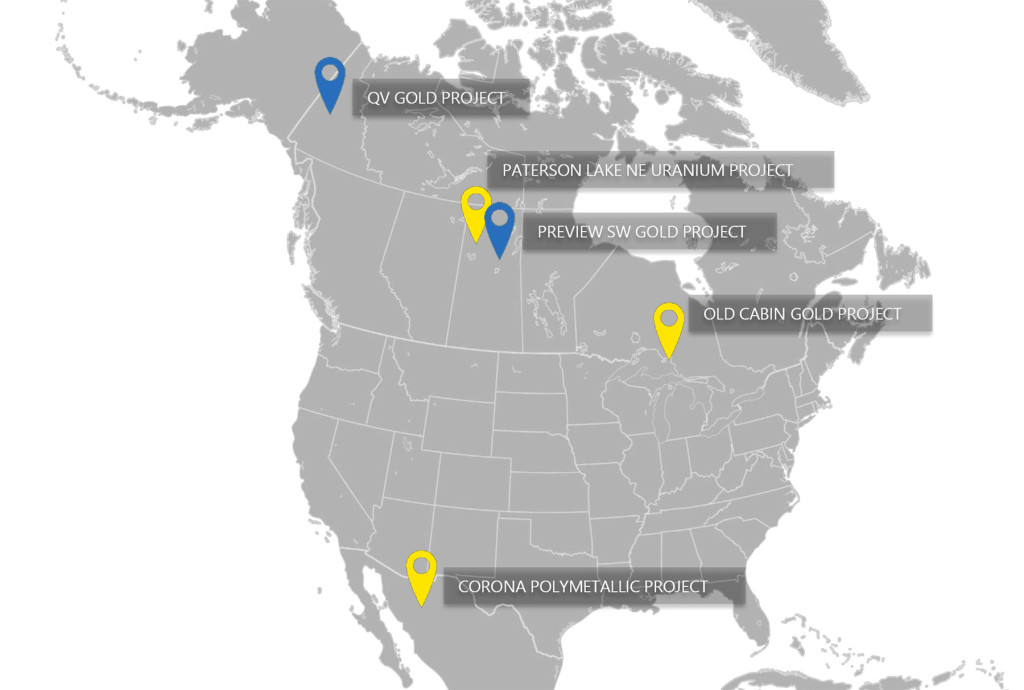
Some might argue the relatively narrow size of the Preview SW zone will result in a high strip ratio, but we wouldn’t necessarily agree with that view. Comstock will indeed have to deal with lower-grade mineralization in between the structures, but as the average grade of the resource estimate is in excess of 1.7 g/t gold, it does look like the project could handle the (low-cost) waste removal. Just to give you an idea, Treasury Metals (TML.TO) budgeted a mining cost of C$3.3 per tonne of waste, so even a strip ratio of 5:1 would cost Comstock just US$12.5 of waste removal expenses per tonne of ore.
Also keep in mind CEO David Terry is an economic geologist and we are fully confident he knows what he’s doing. Of course, the company isn’t even close to initiating a Preliminary Economic Assessment so all these things will be dealt with in due time but we just wanted to convey the message that a higher strip ratio won’t ‘kill’ the project, as the grade of the mineralized zones is quite high for what will be an open pit mine.
As mentioned before, the Preview SW resource estimate was completed on just one of the gold occurrences, and six more (known) targets remain virtually untested. The company has completed a 1,770 meter winter drill program with a specific focus on the Preview North zone, and the assay results of the past winter drill program are very encouraging.
The company has now reported the assay results of the final five holes of the eight-hole winter drill program, and at the North Zone the drill bit has intersected 3 meters containing 2.36 g/t gold whilst hole 168 has intersected some lower-grade mineralization. As you can see on the next image, hole 168 was drilled towards the south-southwest to test a magnetic signature, and the expectations of this hole weren’t extremely high to begin with. At the North zone, these assay results are very encouraging follow-up results on the previously released holes which intersected 2 meters at 9.66 g/t, 1.6 meters at in excess of 80 g/t gold and 5 meters at 10.33 g/t within 12 meters at 4.64 g/t. If anything, the winter drill results confirm the prospectivity of the North zone to be a ‘satellite’ deposit to the ‘main’ Preview SW zone.
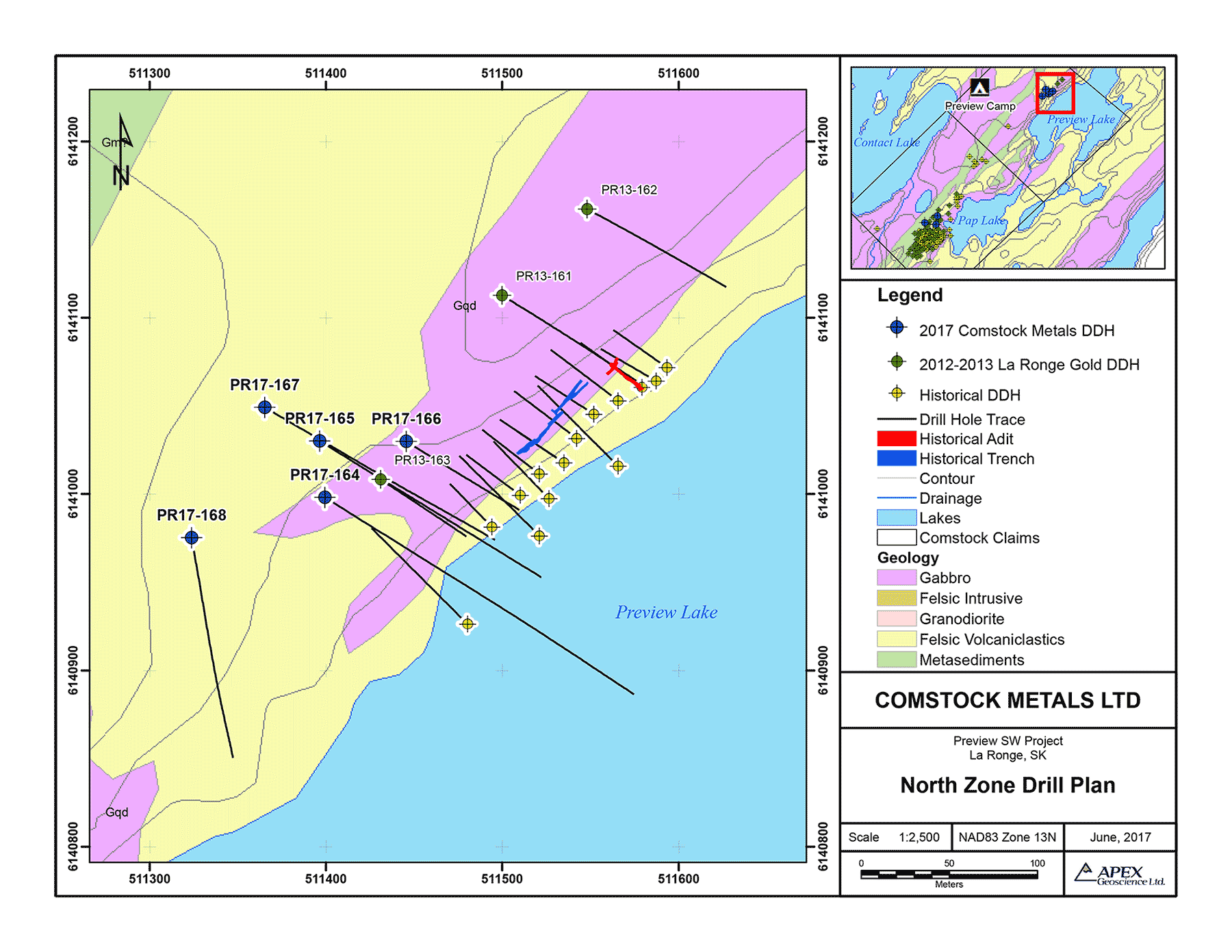
At the Preview SW zone, which hosts the current resource, Comstock has now released an ‘eye-opening’ hole of almost 105 meters at 1.01 g/t gold. The gold grade is indeed lower than the average grade of the existing resource, but this hole confirmed the continuity of the several parallel structures. As you can see on the next image, the longer 105 meter interval includes several narrower higher-grade intervals, and that’s exactly what Comstock was expecting to find.
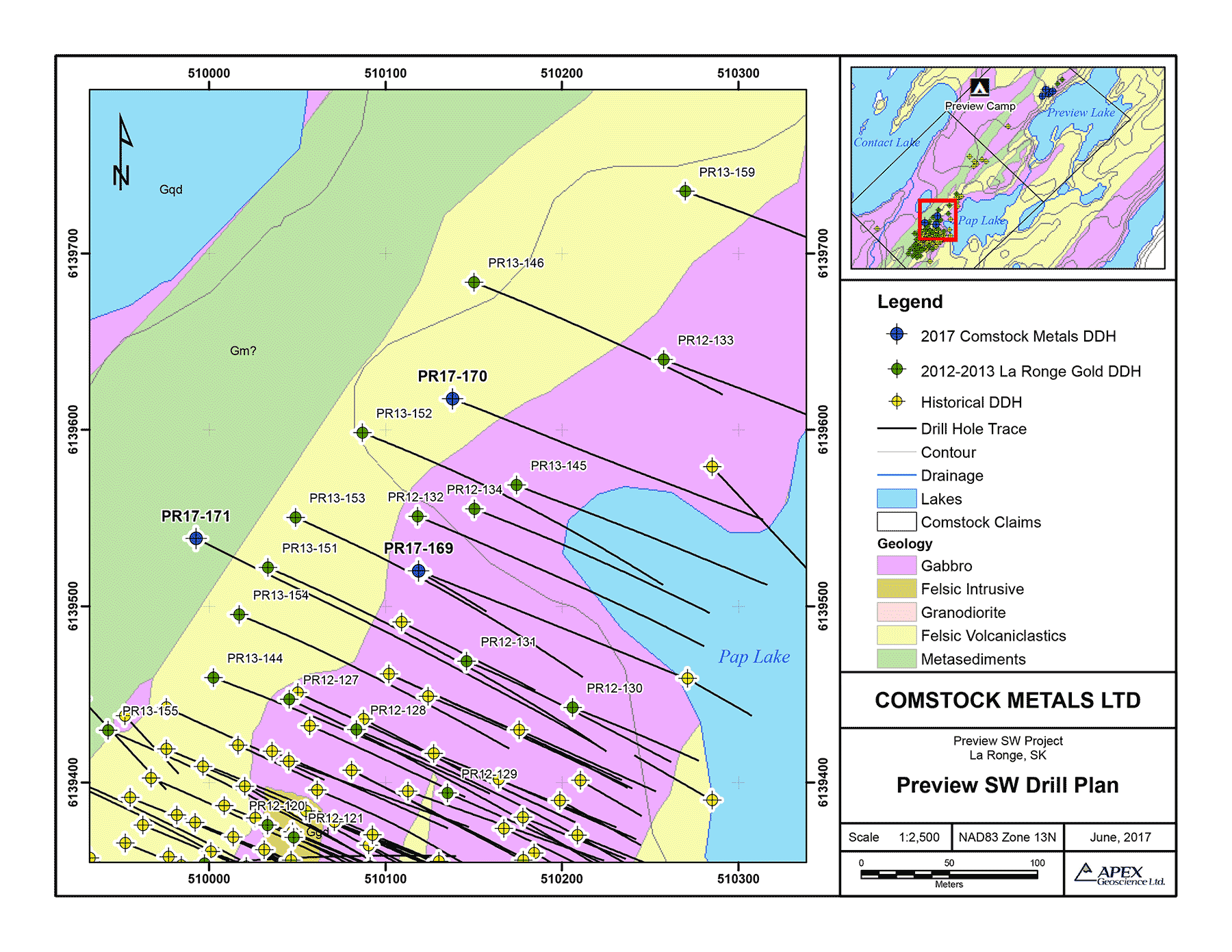
The winter drill results confirmed Comstock should be able to add more tonnes and ounces to the currently known resource at Preview SW and the North Zone, and we’re looking forward to see the company’s summer exploration plans which will undoubtedly be released soon.
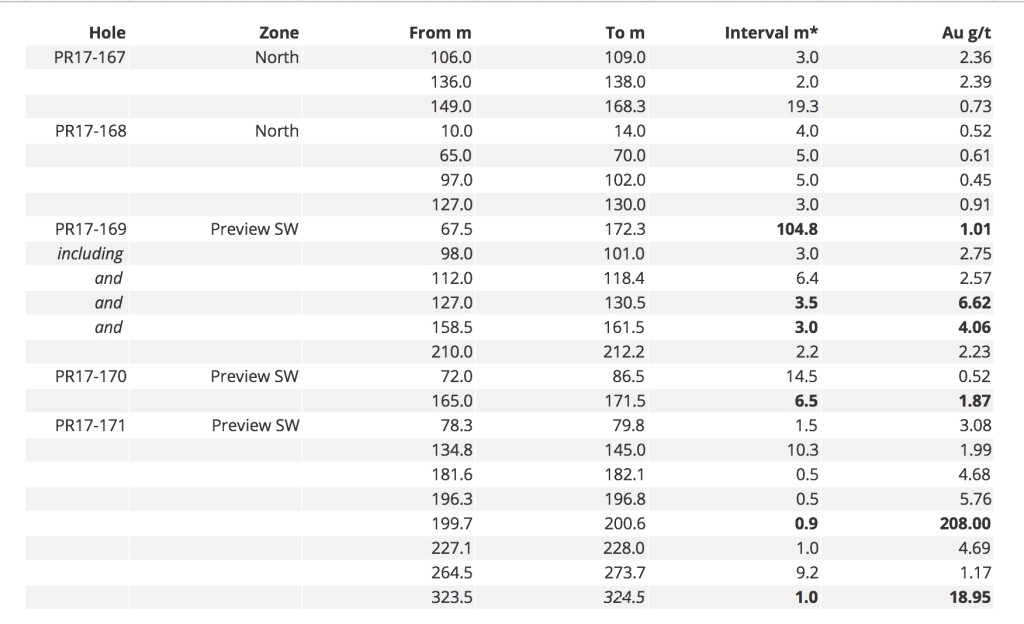
B. QV Gold, Yukon Territory
Comstock Metals’ second project is the QV Gold Project in Canada’s Yukon Territory. What’s really intriguing here is the fact QV is located right across the river from the Golden Saddle project which was sold by Underworld Resources to Kinross Gold (KGC, K.TO), only to see Kinross Gold sell the asset to White Gold (WGO.V), just a few weeks ago.
This transaction is absolutely important as it establishes White Gold as one of the main exploration companies in the Yukon Territory and by combining properties, White Gold seems to be doing what Kinross didn’t do; creating economies of scale by combining properties. A 1 million ounce deposit might be difficult to develop as a standalone project in the Yukon, but once one gets to at least 2 million ounces, the size of a development-stage project is large enough to justify the infrastructure-related expenses.
Considering the proximity of the QV property to White Gold’s Golden Saddle property, it would only make a lot of sense to assume all options and possibilities will be thoroughly investigated further down the road between Comstock metals and White Gold (or perhaps even a senior producer).
So why would QV be a good fit for White Gold (or get on the target list of a major gold producer)?
First of all, Comstock Metals has optioned the property from Shawn Ryan, who now is the Chief Technical Advisor to White Gold, so he will definitely know the QV property. In fact, the QV property is named on the White Gold website as one of his ‘achievements’.
Secondly, Comstock Metals has made a lot of progress since acquiring the property. Although it hasn’t been easy and the capital markets were closed for Yukon-based projects for quite a while, Comstock was definitely able to create value. The company confirmed a mineralized zone of 350 meters by 350 meters, and the type of rock and mineralization encountered at the VG zone is very similar to what Underworld Resources and Kinross Gold found at the Golden Saddle project. The geology, structural control, alteration and surface footprint of the QV project seem to be very similar to Golden Saddle.
Not only does the VG gold zone of the QV project remain open in all (!) directions, it also already contains 230,000 ounces of gold at an average grade of 1.65 g/t. That’s a good start, but Comstock has made a lot of progress since the resource estimate was completed in 2014. The drill results from the 2016 summer drill season were a real eye opener, and last year’s 2,400 meter Rotary Air Blast (‘RAB’) program confirmed several important updates.
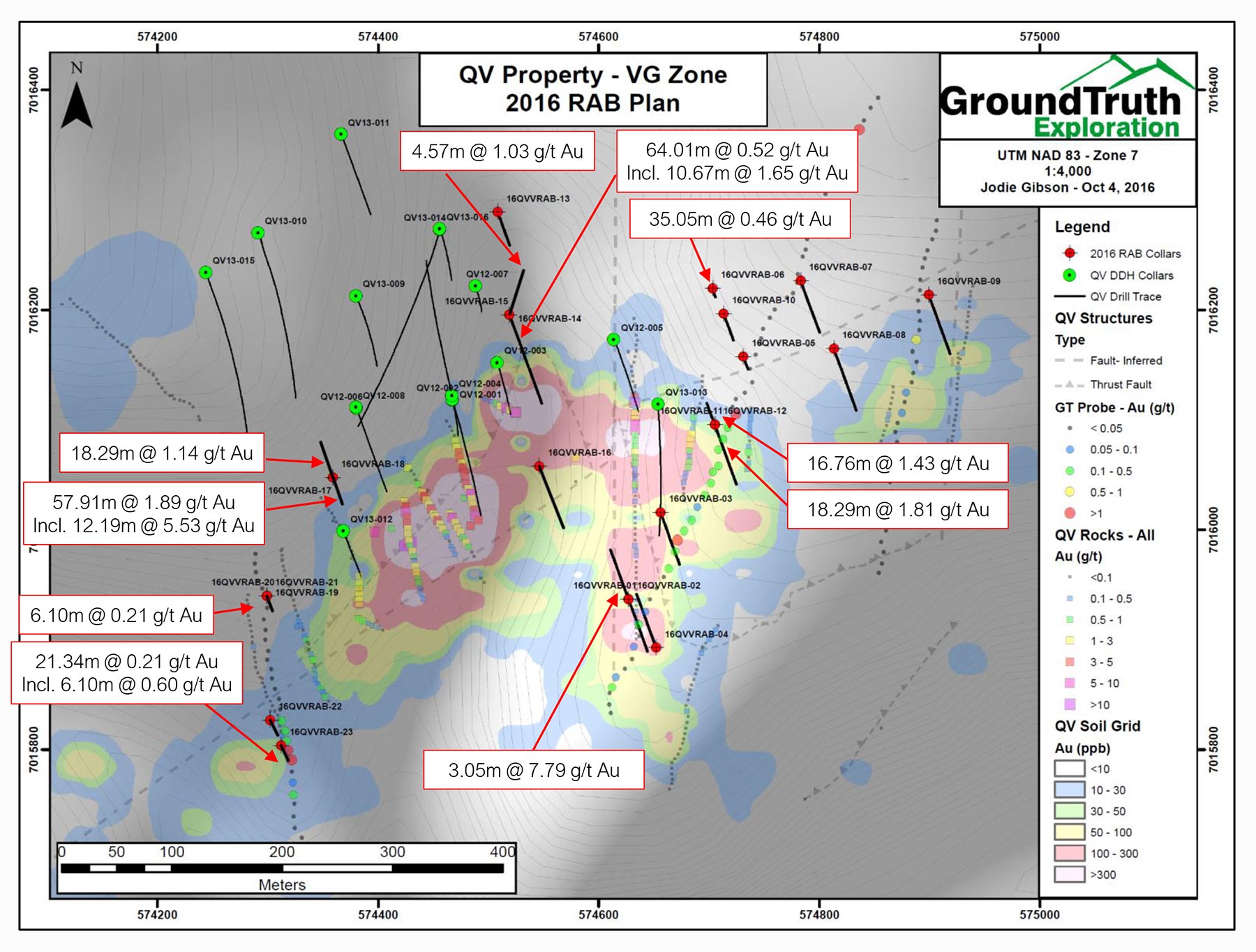
Even though the drill program was small, it did extend the VG zone (on the southern end of the land package) by approximately 55 meters east by intersecting in excess of 18 meters containing in excess of 1.8 g/t gold, but it also confirmed the mineralization continues approximately 200 meters towards the northeast on the north side of the Telegraph fault the ‘yellow zone’, whilst hole 17 towards the southwest of the VG zone encountered 12 meters of in excess of 5 g/t gold within a wider interval of almost 60 meters averaging almost 1.9 g/t gold (the blue rectangle on the left hand side of the map).
None of these economic-grade drill results were drilled within the zone which hosts the current 230,000 ounce resource estimate, so the path to delineate a million ounces on the 16,000 hectare QV land package is very realistic, especially considering Comstock Metals is still working on three additional ‘high priority’ exploration targets, as you can see in the next image.
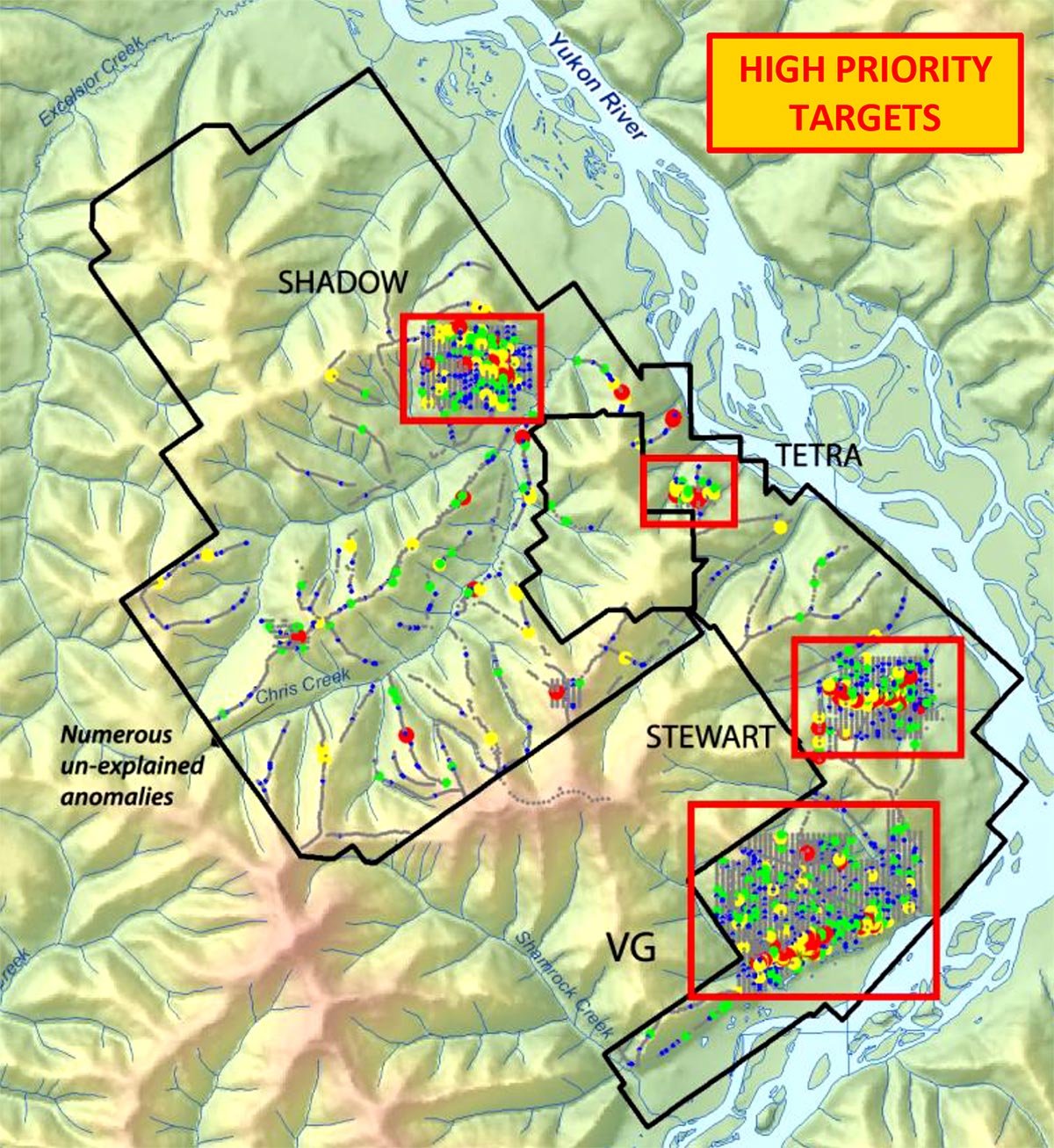
Just to state the obvious, we have literally no doubt the current resource estimate containing 230,000 ounces of gold at the QV gold project is just the beginning. The 2016 exploration season has been successful in extending the known mineralization, whilst three other high-priority mineralized zones on the wider land package also have the potential to add near-surface ounces to the mix.
For now, Comstock may continue to use a RAB drill rig to reduce its cost per drilled meter but as one can’t include RAB drill results in resource calculations, Comstock will have to complete a RC/Diamond Drill program in order to add to NI43-101 resources. We expect the company to announce its exploration plans soon, and we hope to see a diamond drill component to complement planned exploration work.
What is Comstock planning to do this year?
As the summer season is starting, Comstock Metals is gearing up to ‘get back in the field’ on both the Preview and QV Gold projects. The company hasn’t announced its exploration programs for this summer just yet, but it will very likely want to follow up on the excellent drill results from last year and we expect to see the company unveiling its plans in the next few weeks.
Additionally, Comstock Metals will probably try to complete more metallurgical test work as well, with a clear focus on the Preview project. The preliminary metallurgical test work at Preview resulted in the company confirming the potential to produce gold concentrate, recovering 90-93% of the gold.
That’s a great start and increasing the recovery rate might be one of the ‘easiest’ ways to increase the value at Preview as we would expect Comstock to start thinking about the project’s economics as it advances towards the million ounce mark. A recovery rate of 91.5% is good, but boosting it to 94% would result in an additional 25,000 ounces being recovered for an additional revenue of in excess of C$40M without any additional investment. Of course, we’re still years away from a construction or development decision and this will completely depend on finding more (viable) ounces, but it’s important to keep the bigger picture in mind. Every 1% increase in the average recovery rate will add a lot of value to the project (on an undiscounted and pre-tax basis).
Upon reading the technical report of the Preview project we noticed the concentrate contained a considerable amount of arsenic, and we discussed this with CEO David Terry to see if this would have any implications on the smelter front.
Apparently the gold does not appear to be tied up with arsenopyrite and it’s not unlikely additional test work will confirm the potential to produce a gravity concentrate with a lower arsenic content, whilst the other part of the concentrate could be amenable to leaching, as indicated by historical test work, or it could be sold to a smelter and potentially blended with other concentrates. Again, the currently known metallurgical test results are very preliminary in nature and it’s virtually impossible Comstock would not be able to improve them.
And of course, everything always is a function of the available cash resources. As of the end of March, Comstock Metals had C$3.4M in cash, and a total working capital of approximately C$3.1M, so the company is in a pretty good shape. As both projects are located in Canada (Yukon Territory and Saskatchewan), it could make sense for Comstock Metals to investigate the opportunity to raise some flow-through funds at a premium to the current share price to fund (a part of) its exploration plans for this year.
Preview SW Gold Property
Avoiding any geopolitical risk is an important factor
If you look at pretty much all the M&A deals executed in the past 18 months, you’ll see most of the acquirers have been targeting properties and projects in safe places. Most senior producers who went to the more exotic places in the world lost their shirt and this has reduced their risk appetite. Goldcorp (GG, G.TO) bought Kaminak Gold, Tahoe Resources (TAHO, THO.TO) merged with Lake Shore Gold, Silver Standard Resources (SSRI, SSO.TO) acquired Claude Resources (which was operating the underground Seabee mine in, yes indeed, Saskatchewan) and more recently, Integra Gold (ICGV) has accepted a buyout offer from Eldorado Gold (EGO, ELD.TO).
What do these transactions have in common? Senior precious metals producers are now, more so than ever before, focusing on safe jurisdictions. And they are willing to pay the premium price for it.
Looking at the most recent update from the Fraser Institute which ranks the world’s mineral jurisdictions based on several parameters, Saskatchewan and the Yukon Territory definitely are some of the best regions in the world to be operating in.
As you can see on the next image, Saskatchewan actually ranks first in the ‘Investment Attractiveness Index’, whilst the Yukon Territory comes in ahead of Ontario and British Columbia:
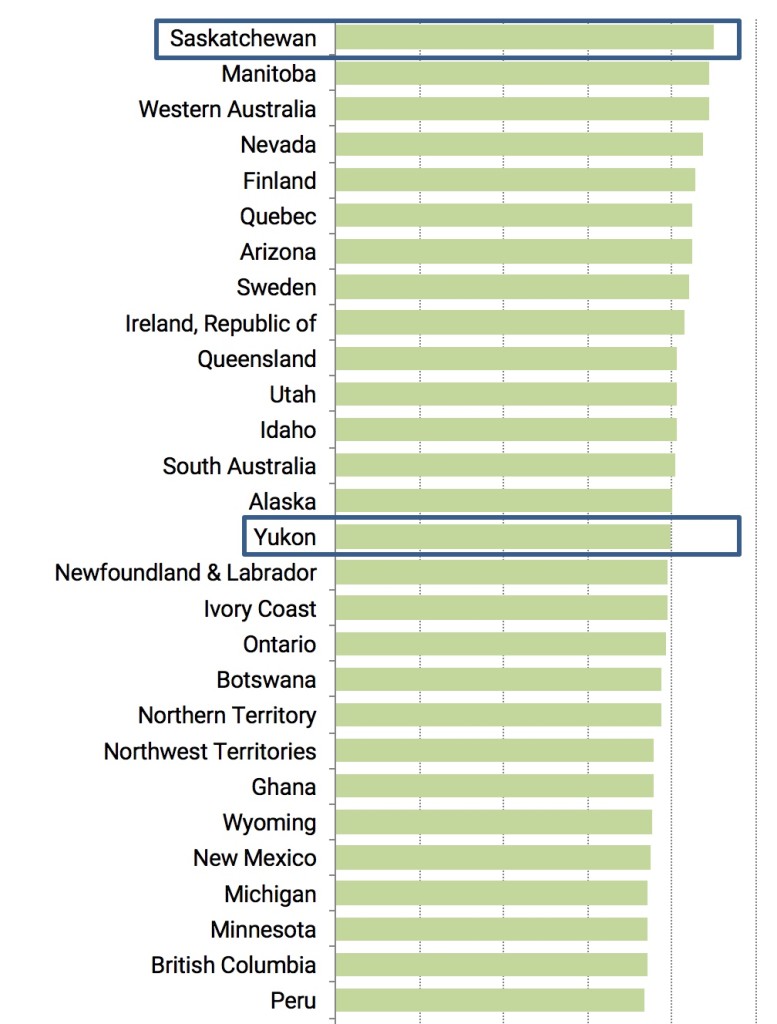
Where do we see the company evolve to?
With existing resource estimates on both projects, Comstock Metals definitely isn’t a greenfield exploration company, and the best way to create shareholder value is to add more ounces to both resources.
We see the Preview SW project as Comstock Metals’ flagship project. The current 430,000 ounce resource estimate is very clearly just the beginning, and further down the road, we see a total potential of +1 million ounces at Preview. We expect the company to want to reach the 1 million ounce mark before initiating a PEA to figure out the economics of an open pit operation at Preview, so the upcoming drill programs will go a long way to demonstrate the potential to outline additional resources.
It will also be very interesting to see the ‘end game’ for the QV Gold project. Unless you have in excess of 2 million ounces, it’s really difficult to develop a gold project in the Yukon Territory on a standalone basis. Goldcorp will be able to build the Coffee mine, but Kinross’ Golden Saddle project was very likely too small to be viable on a standalone basis.
And that’s exactly why it’s important to see White Gold consolidating Yukon assets, and further down the road it might be interesting to see A) how White Gold will advance its own assets and B) how developments in the region may impact Comstock’s QV.
QV Gold Property
Comstock’s management team
David A. Terry, Ph.D., P.Geo. – President & CEO / Director
Dr. Terry is a professional economic geologist, senior executive and corporate director with more than 25 years of international experience in the mineral resources sector. In the course of his career Dr. Terry has held executive positions and directorships with a number of publicly-listed and private mineral resource companies. He has also worked with a number of senior mining companies including Boliden Limited, Westmin Resources Limited, Hemlo Gold Mines Inc., Cominco Limited and Gold Fields Mining Corporation. Dr. Terry holds a B.Sc. and Ph.D. in geology from Western University in Ontario and is a member of the Association of Professional Engineers and Geoscientists of British Columbia.
Rasool Mohammad, B.Sc. – Chairman/Director
Mr. Mohammad has worked in mining and mineral exploration industry throughout the Americas. He graduated from the NWFP University of Engineering and Technology, Peshawar, Pakistan in 1991 with a B.Sc. (Mining Engineering). He has over 20 years of work experience in the mining and mineral exploration industry. He speaks English, Spanish, Urdu and Pashto. Mr. Mohammad is COO / Director of Select Sands Corp (V.SNS).
Douglas Turnbull, , B.Sc., P.Geo. – Director
Douglas Turnbull is a consulting geologist with over 20 years’ experience in diamond, precious and base metal exploration. He holds an Honours Bachelor of Science degree in Geology and is a Qualified Professional Geoscientist recognized by the Association of Professional Engineers and Geoscientists of British Columbia. Turnbull is the President of Lakehead Geological Services Inc., a geological consulting company based in Vancouver, Canada, and provides a variety of exploration services to exploration and mining companies. He has been fortunate to have been part of mining teams responsible for the exploration and development of the Eskay Creek Gold Deposit in British Columbia, Canada, the Petaquilla Cu-Au Porphyry Deposit in Panama, the Mt. Kare Gold Deposit in Papua New Guinea and the OJVG Sabodala Gold Deposits in Senegal. In addition to Comstock, he currently serves as a director on the boards of Select Sands Corp. and Grizzly Discoveries Inc.
Ken Kuchling, P.Eng. – Director
Mr. Kuchling brings with him over 35 years’ experience in mine engineering, mining operations and consulting across a variety of commodities including precious metals, base metals, bauxite, iron ore, tungsten, molybdenum as well as diamonds and potash. Throughout his consulting career he has had direct involvement in scoping and feasibility studies, project management, 43-101 technical reports, economic modelling, mine design, and environmental permitting. Mr Kuchling has project experience working in various regions in Canada, Alaska, Mexico, Panama, Argentina, Suriname, Russia, South Korea, Italy, Spain, and Senegal. He was involved in the design stage and environmental permitting of the Diavik Diamond Project in the Northwest Territories and has experience with tropical to Arctic mining conditions.
Mr. Kuchling is a mining engineering graduate from McGill University and holds a Masters of Mine Engineering from University of British Columbia. He is also a member of Professional Engineers Ontario (PEO) and currently lives in Toronto Ontario.
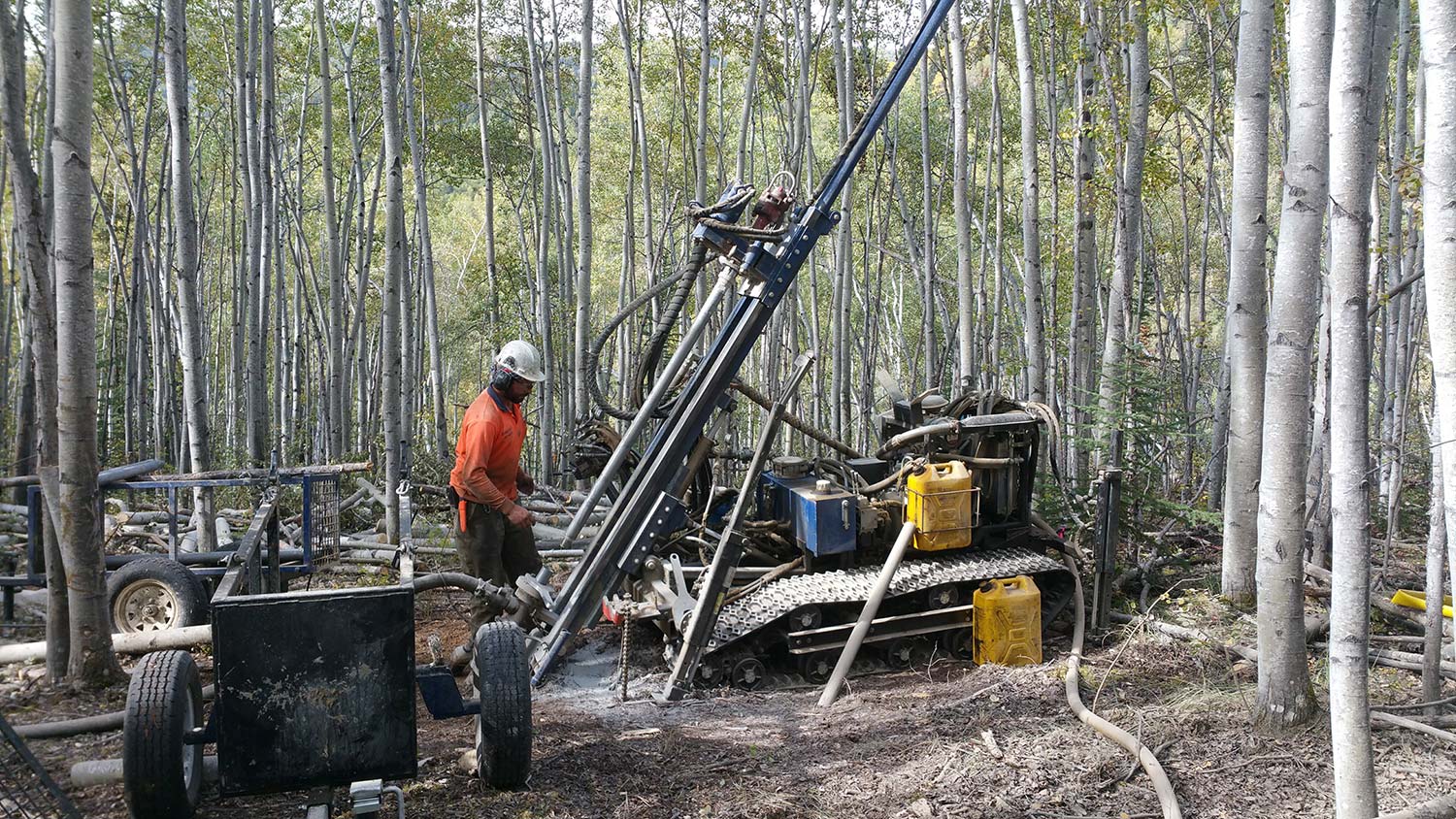
Conclusion
We like the fact Comstock Metals isn’t a one-trick pony, and both assets have a good shot at reaching the critical mass needed to start thinking about developing the projects into mines. The near-term focus will be on building ounces and with in excess of C$3M in the bank, Comstock Metals is in a good shape to continue its exploration activities on both projects.
At its current market capitalization of C$12.1M (resulting in an enterprise value of C$9M), Comstock Metals is trading cheap based on ounces in the ground (C$13-15/oz) versus its exploration potential. Once Preview reaches the million ounce mark, we think Comstock Metals will be sitting on a very viable open pit operation, mining rock at an average grade of well in excess of 1 g/t gold.
It’s now up to David Terry and his team to advance both projects, and we’re fully confident in his ability to add more ounces.
Disclosure: Comstock Metals is a sponsor of the website. We have a long position.
